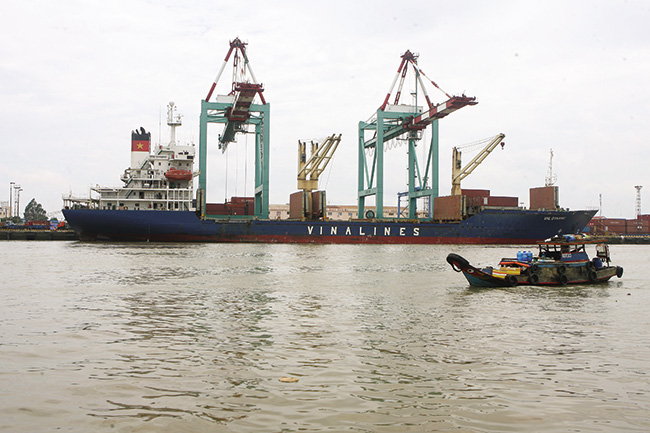Vinalines’ deferred IPO deters foreign investors
 |
| Vinalines’ divestment from its loss-laden ports would allow for greater operational efficiency Photo: Le Toan |
The Ministry of Transport (MoT) has submitted a proposal to the government for the re-evaluation of Vinalines’ corporate value, thus moving it more in line with current market conditions.
“The re-evaluation, which is expected to take about two months, is warranted as the evaluation which was fixed at VND21.1 trillion (around $1 billion) at the end of 2013 is outdated,” Vu Anh Minh, head of the MoT’s Department for Enterprise Management, told VIR.
Vinalines’ initial public offering (IPO) was due to be launched in the first quarter of 2015. The firm proposed removing five ships, namely Vinalines Global, Vinalines Ocean, Vinalines Sky, Vinalines Trader, and Vinalines Ruby from the list of assets subjected for corporate evaluation. However, the suggestion was turned down.
Due to difficulties in corporate evaluation, the IPO was delayed until the first quarter of 2016. Many months have passed leaving it severely behind schedule and with still no approval from the government.
The delay has raised doubts among foreign investors, including SSA Marine, concerned with whether the government would reduce the state’s stake holding to 36 per cent as previously expected. The dilemma for foreign investors is whether to make further investments in their loss-laden joint venture ports.
At a meeting with the MoT’s leaders in late 2015, the US-backed SSA Marine was eager to discuss debt restructuring with Vinalines’ new potential investors, before making any further plans on financing operations in SSIT and CICT – the two joint venture ports between SSA Marine and Vinalines.
SSA Marine hoped that Vinalines’ plans to divest a part of the state’s stake in joint venture terminals to other capable investors would be accelerated to increase their operational efficiency. However, the progress so far has been slow.
“We will only invest further in these two joint venture ports if prospects look good,” said Soren Pedersen, deputy marketing manager of SSA Marine.
The US operator has yet to announce its schedule of continued investment in SSIT, located in the Cai Mep Thi Vai area in the southern province of Ba Ria-Vung Tau.
So far, 90 per cent of the port has been developed. However, since lenders have ceased their funding, the port has only served dry cargo vessels.
Although CMIT, a joint venture between Saigon Port and Danish company APMT, proposed a co-operation programme with SSIT, the operator has shown some hesitation as information about prospective investors remains unclear.
The operators of CMIT and SP-PSA (between Vinalines and Singaporean PSA), are in a similar situation. After suffering years of losses, they are anxiously awaiting the breathing room which would arise from the equitisation plan.
As of 2015, those joint venture ports’ total accumulated losses reportedly stand at nearly VND6.3 trillion ($288.9 million).
According to foreign port operators, privatisation is the best option to increase operational efficiency and to attract foreign investors to the joint venture terminals. For example, after T&T Group acquired Quang Ninh Port from Vinalines, the port’s operational efficiency dramatically improved. The port recorded revenue of VND185 billion ($8.48 million) in the first six months of 2015, while net profit in the period reached VND26.6 billion ($1.22 million), nearly 16 times that recorded in the first half of 2014.
What the stars mean:
★ Poor ★ ★ Promising ★★★ Good ★★★★ Very good ★★★★★ Exceptional
Latest News
More News
- Global partnerships key to Vietnam’s IFC development (December 26, 2025 | 16:18)
- Vingroup pulls out of bid to invest in North-South high-speed railway (December 26, 2025 | 11:42)
- Strengthening supply chains through trade promotions and customs reform (December 24, 2025 | 14:00)
- PM orders investment model for North–South high-speed rail (December 22, 2025 | 17:43)
- LS Eco Energy to invest in Vietnam rare earth sector (December 22, 2025 | 17:31)
- Government moves to establish International Financial Centre (December 21, 2025 | 21:00)
- Vietnam's IFC to target global investment flows (December 21, 2025 | 18:00)
- Two national hospitals expand capacity with new facilities (December 20, 2025 | 09:00)
- Ha Tinh breaks ground on major Vingroup industrial and energy projects (December 19, 2025 | 18:24)
- EVN launches major power infrastructure projects nationwide (December 19, 2025 | 18:17)

















 Mobile Version
Mobile Version